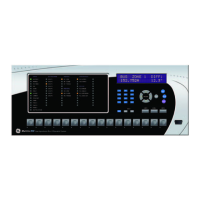5-182 B90 LOW IMPEDANCE BUS DIFFERENTIAL SYSTEM – INSTRUCTION MANUAL
CONTROL ELEMENTS CHAPTER 5: SETTINGS
5
GROUP 2 ACTIVATE ON to GROUP 6 ACTIVATE ON — Selects a FlexLogic operand which, when set, makes the particular setting
group active for use by any grouped element. A priority scheme ensures that only one group is active at a given time — the
highest-numbered group that is activated by its
ACTIVATE ON parameter takes priority over the lower-numbered groups.
There is no activate on setting for group 1 (the default active group), because group 1 automatically becomes active if no
other group is active.
SETTING GROUP 1 NAME to SETTING GROUP 6 NAME — Allows the user to assign a name to each of the six settings groups.
Once programmed, this name appears on the second line of the
GROUPED ELEMENTS SETTING GROUP 1(6) menu display.
A setting group selection can also be made by the IEC 61850 MMS service SelectActiveSG to the control block @Master/
LLN0.SGCB. The priority scheme mentioned makes active the highest numbered group selected by SelectActiveSG or the
GROUP ACTIVATE ON settings. The SelectActiveSG selection has a default value of 1, so until a higher SelectActiveSG
selection is received, the
GROUP ACTIVATE ON settings control the active group.
The most recent SelectActiveSG selection is preserved while the UR is powered down or reset.
If it becomes necessary to cancel the SelectActiveSG selection without using a SelectActiveSG service request, change the
SETTING GROUPS FUNCTION setting to Disabled. This resets the SelectActiveSG selection to 1.
5.7.4 Digital elements
SETTINGS CONTROL ELEMENTS DIGITAL ELEMENTS DIGITAL ELEMENT 1(48)
There are 48 identical digital elements available, numbered 1 to 48. A digital element can monitor any FlexLogic operand
and present a target message and/or enable events recording depending on the output operand state. The digital element
settings include a name to be referenced in any target message, a blocking input from any selected FlexLogic operand,
and a timer for pickup and reset delays for the output operand.
DIGITAL ELEMENT 1 INPUT — Selects a FlexLogic operand to be monitored by the digital element.
DIGITAL ELEMENT 1
DIGITAL ELEMENT 1
FUNCTION: Disabled
Range: Disabled, Enabled
DIG ELEM 1 NAME:
Dig Element 1
Range: up to 16 alphanumeric characters
DIG ELEM 1 INPUT:
Off
Range: FlexLogic operand
DIG ELEM 1 PICKUP
DELAY: 0.000 s
Range: 0.000 to 999999.999 s in steps of 0.001
DIG ELEM 1 RESET
DELAY: 0.000 s
Range: 0.000 to 999999.999 s in steps of 0.001
DIGITAL ELEMENT 1
PICKUP LED: Enabled
Range: Disabled, Enabled
DIG ELEM 1 BLOCK:
Off
Range: FlexLogic operand
DIGITAL ELEMENT 1
TARGET: Self-reset
Range: Self-reset, Latched, Disabled
DIGITAL ELEMENT 1
EVENTS: Disabled
Range: Disabled, Enabled
Digital elements run once per power system cycle.
As such they can easily fail to react to an input signal or a block signal with a duration less than one power system
cycle. This also means that digital element output can react up to one power system cycle later than the pickup
and reset delay settings indicate.
Do not use digital elements with transient signals, such as communications commands. Do not use digital
elements where random delays of up to one cycle cannot be tolerated, such as in high speed protection.

